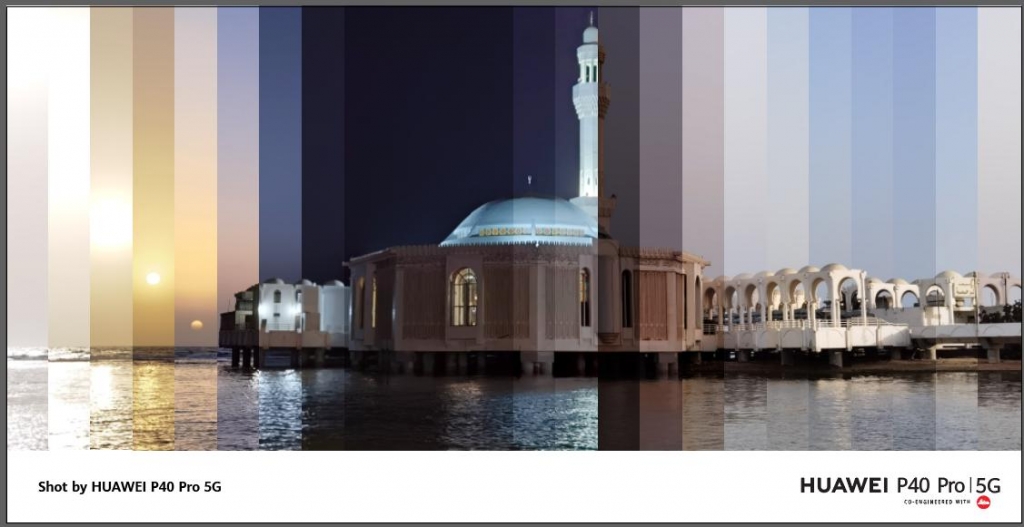
An Impressive Around the Clock Shots in Different Light Conditions by the HUAWEI P40 Pro
Huawei is providing advanced professional photography to the hands of mobile device users with its latest smartphone, the HUAWEI P40 Pro. The HUAWEI P40 Pro introduces a new age of ultra high-performance mobile imaging, in one of Huawei’s most advanced devices to date, which combines Huawei’s most powerful SoC processor ever, with the largest ever main camera sensor on a smartphone.
The power of HUAWEI’s P40 Pro to deliver the highest quality photography was demonstrated recently by the professional photographer Adel Mohammed Al-Ghamdi and Mohammed Al-Khathery. The Saudi photographers used the HUAWEI P40 Pro to capture 24 hours of scenic shots of King Abdullah Financial District (KAFD) in Riyadh and AlRahma Mosque in Jeddah, making the most of the advance features of the phone and its outstanding battery life.
The HUAWEI P40 Pro builds on Huawei’s legacy of advanced, high-quality mobile photography, by introducing some of the most powerful imaging hardware and software ever seen in a HUAWEI smart device. The HUAWEI P40 Pro features a host of advanced photographic capabilities, to make premium photography available to everyone.
At the heart of the enhanced imaging features of the HUAWEI P40 Pro is the new main camera sensor. The 1/1.28-inch sensor is the largest CMOS sensor ever seen on a smartphone, powering the 50MP Ultra Vision Wide Camera. At nearly one inch across diagonally, the larger 50MP sensor allows for larger pixel size, which provides greater light-gather capability, which in turn delivers performance increases in many areas including better dynamic range, more accurate colour and more detailed tonal reproduction.
The main 50MP sensor supports 4-in-1 pixel binning, which means the light information from multiple photo sites can be combined together into a singular pixel with a much higher full well capacity. Here, it results in a ‘super’ pixel that measures 2.44μm – one of the largest smartphone camera pixel sizes to date. The massive pixel size lets the device deliver better signal-to-noise ratio, allows for better flexibility in post-processing and achieves greater low-light performance.
The main image sensor is just one element of the advanced hardware, software and AI capabilities of the HUAWEI P40 Pro. Additional features such as Huawei’s exclusive RYYB colour filter array (CFA), and fifth-generation ISP, Da Vinci architecture NPU, and proprietary image processing algorithms are integrated into an end-to-end camera solution that delivers outstanding photography performance for all types of photography.
To complement the powerful main camera, the HUAWEI P40 Pro packs a 5x optical telephoto 12MP camera, with Ultra Vision Leica Quad Camera, and RYYB CFA, to give highest quality photography results for up close or far away. The telephoto camera features a periscope design, which means it can pack a 10x hybrid zoom and 50x maximum zoom, within a small form factor. For best quality images, even at long range zoom, the HUAWEI P40 Pro includes AI Image Stabilisation (AIS) technology and optical stabilization.
With the HUAWEI P40 Pro, the low light is no longer be a problem because the Ultra Vision Wide Camera has amazing photosensitivity, which extends far beyond what the human eye is able to see, enabling it to pick out levels of detail in low light situations that the human eye simply does not comprehend. The new AI portrait algorithms then take this one step further by increasing the brightness of the subject’s face for night portraits. Even in a super dim environment with no lighting, the device helps you capture photos with layering details and vibrant colours.
The front camera on the HUAWEI P40 Pro continues the high performance theme, with a 32MP AF Camera, an IR Depth Camera, as well as an ambient light and proximity sensor. The main camera can capture sharp, static photos, as well as record 4K 60fps UHD videos that have finer details, capturing the nuances of skin texture, hair and eyelashes. The IR Depth Camera utilizes depth of field data processing, and autofocus, to produce high quality selfies from up close or using a selfie stick.
For video, the HUAWEI P40 Pro has a 40MP Ultra wide cine camera, which is also enhanced with advanced features. The camera is the best low-light video camera on a Huawei device, with ISO 51200 light sensitivity to support ultra low-light video capture. The cine camera is further enhanced with ultra slow motion captures, and directional audio zoom, which enables the user to simultaneously zoom in on an audio source and amplify its sound, to create dynamic sports scenes with on-the-spot sounds.
The advanced capabilities of the front and rear cameras are supported with advanced software and AI. The Huawei XD Fusion Engine combines data from multiple cameras on the HUAWEI P40 Pro, and applies semantic interpretation and segmentation and image processing, to greatly enhance image details and image quality.
A powerful suite of proprietary AI algorithms supports advanced image processing and provide users with multiple options and capabilities to enhance their photography in innovative new ways. Huawei’s third-generation AI Image Processing Engine processes images pixel by pixel, which can be used to optimize images in many different ways. Features such as enhanced backlighting, skin tone enhancer and advanced Bokeh effects allow users to create high quality portraits. AI Best Moment feature allows users to remove reflections and passersby from pictures.
The high-speed processor of the HUAWEI P40 Pro means that AI processing can be applied rapidly to images, and to enable new effects. HUAWEI Golden Snap, for example, takes several frames in the instant before and after the user presses the shutter. This creates multiple frames which can be used by the image processing to get the best possible results.
Even with all of the advanced features of the HUAWEI P40 Pro, the handset is still designed to keep users connected and taking photos all day long, with a 4200 mAh battery delivering long lasting power, and support for HUAWEI Wired and Wireless SuperCharge to enable users to rapidly recharge.


























